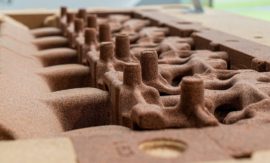Intended learning outcomes: Disclose various batch sizing policies, namely lot-for-lot, optimum number of (merged) demands, optimum number of partial lots, optimum batch size (economic order quantity, EOQ). Explain the “blowthrough” technique linked with the lot-for-lot sizing policy.
A batch-sizing policy or lot-sizing policy is a set of techniques that create production or procurement batches from net requirements.
In practice, there are various possible batch sizing policies:
1.) Lot-for-lot: every net requirement translates into just one planned order. Variation: if the component batch sizes fall below a certain quantity, a “blowthrough” of the component requirements right into the requirements given by its bill of material and its routing sheet may take place (see description below).
2.) A dynamic lot size, made up of an optimum number of merged demands. If this number is 1, then the situation is again one of make to order.
3.) A dynamic lot size with an optimum number of partial lots. This policy suggests splitting the demand into several orders. Another attribute determines the minimum deferral time between two of these orders.
4.) A fixed order quantity, known as the optimum batch size, either determined manually or calculated using the EOQ (economic order quantity) formula, for example (see Section 11.4.2). If two orders are closer together than the specified minimum deferral time, they are procured in a single batch (multiples of the EOQ).
All batch-sizing policies, except the fourth, result in so-called discrete order quantities.
A discrete order quantity is an order quantity that represents an integer number of periods of demand. That means that any inventory left over from one period is sufficient to cover the full demand of a future period.
The following additional aspects of the various batch-sizing policies should be considered:
- The “blowthrough” technique linked with the lot-for-lot sizing policy: Designers tend to define structural levels that correspond to the modules of a product. However, in the production flow, the modules are not always meaningful, since some products are manufactured in one go. This is often the case with single-item production, and requires — de facto — extended phantom bills of material. The blowthrough technique drives requirements straight through the phantom bill of material to its components and combines the operations in a meaningful order. Thus, the technique converts several design structure levels to a single production structure level (see the definitions of these terms in Sections 1.2.2 and 1.2.3). At the same time, the multilevel design bill of material is transferred to the associated single-level production bill of material. Figures 12.4.1.1 and 12.4.1.2 show as an example product X, which is made up of two longitudinal parts L and two transverse parts Q, each made from the same raw material. The information is shown before and after the “blowthrough” of requirements through L and Q. See also [Schö88a], p. 69 ff.
Fig. 12.4.1.1 Bills of material and route sheets for a product X from the viewpoint of design.
Fig. 12.4.1.2 Bills of material and route sheets for a product X: structure from the production viewpoint, after “blowthrough” of requirements through L and Q.
For the 2nd to the 4th batch-sizing policies, you can also specify whether the optimum values should be calculated or set manually. Maximum and minimum values can be assigned to restrict these optimum values if the calculation returns unusual values.
The 2nd and the 3rd batch-sizing policies are particularly important for harmonious or rhythmic production, in which a certain quantity leaves production during each unit of time. The components should be procured at a similar rate.
The 3rd batch-sizing policy, or batch splitting, is used if the specified requirement in total is not needed all at the same time. For an assembly batch of 100 machines, for example, not all the components will be needed at once, since the machines are assembled one after the other. Thus, two partial batches could be created, if necessary, for producing or procuring components, and the second partial batch could be channeled into the assembly process some time after assembly starts.
With the 4th batch-sizing policy, or fixed order quantity, physical inventory is inevitable, since more items are generally procured than are needed to satisfy demand. This policy should therefore only be used if the inventory level will actually be reduced, that is, when it is safe to assume that demand will really occur in the future. This is the case if future demand can be determined on the basis of past consumption — at least where demand is regular. This batch-sizing policy is therefore not economically viable for lumpy demand.
Continuation in next subsection (12.4.1b), for the 5th, 6th, and 7th batch-sizing policies .
Course section 12.4: Subsections and their intended learning outcomes

12.4 Batch Sizing, or Lot Sizing
Intended learning outcomes: Explain combining net requirements into batches. Differentiate between different batch-sizing policies.

12.4.1 Combining Net Requirements into Batches by Policies such as Lot-for-lot, Optimum Number of Merged Demands or Partial Orders, and Economic order quantity (EOQ)
Intended learning outcomes: Disclose various batch sizing policies, namely lot-for-lot, optimum number of (merged) demands, optimum number of partial lots, optimum batch size (economic order quantity, EOQ). Explain the “blowthrough” technique linked with the lot-for-lot sizing policy.

12.4.1b Batch Sizing Policies such as Period Order Quantity (or Optimum Length of Order Cycle), Part Period Balancing (PPB), Dynamic Optimization
Intended learning outcomes: Disclose various batch sizing policies, namely the period order quantity (or optimum length of order cycle), part period balancing (PPB), dynamic optimization.

12.4.2 Comparing Dynamic Optimization, Part Period Balancing (PPB), Period Order Quantity (or Optimum Length of Order Cycle), and Economic Order Quantity (EOQ)
Intended learning outcomes: Explain, using an example, the comparison of various batch-sizing policies, namely dynamic optimization, part period balancing (PPB), the period order quantity (or optimum length of order cycle), and the optimum batch size (economic order quantity, EOQ).
